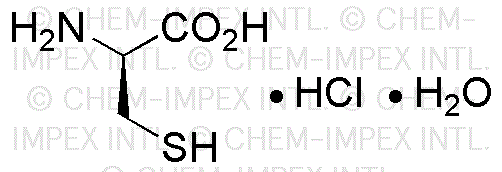D-Cysteine hydrochloride is widely utilized in research focused on:
- Biochemical Research: This compound is essential for studying protein synthesis and enzyme function, particularly in the context of cysteine-rich proteins.
- Pharmaceutical Development: It serves as a building block in the synthesis of various pharmaceuticals, especially those targeting antioxidant pathways and neuroprotective agents.
- Food Industry: Used as a flavor enhancer and a dough conditioner, it improves the texture and shelf life of baked goods.
- Cosmetic Formulations: D-Cysteine hydrochloride is incorporated into skincare products for its antioxidant properties, helping to protect skin from oxidative stress.
- Research on Genetic Disorders: It plays a role in studies related to cysteine metabolism and its implications in genetic conditions, offering insights into potential therapeutic approaches.
General Information
Properties
Safety and Regulations
Applications
D-Cysteine hydrochloride is widely utilized in research focused on:
- Biochemical Research: This compound is essential for studying protein synthesis and enzyme function, particularly in the context of cysteine-rich proteins.
- Pharmaceutical Development: It serves as a building block in the synthesis of various pharmaceuticals, especially those targeting antioxidant pathways and neuroprotective agents.
- Food Industry: Used as a flavor enhancer and a dough conditioner, it improves the texture and shelf life of baked goods.
- Cosmetic Formulations: D-Cysteine hydrochloride is incorporated into skincare products for its antioxidant properties, helping to protect skin from oxidative stress.
- Research on Genetic Disorders: It plays a role in studies related to cysteine metabolism and its implications in genetic conditions, offering insights into potential therapeutic approaches.
Documents
Safety Data Sheets (SDS)
The SDS provides comprehensive safety information on handling, storage, and disposal of the product.
Product Specification (PS)
The PS provides a comprehensive breakdown of the product’s properties, including chemical composition, physical state, purity, and storage requirements. It also details acceptable quality ranges and the product's intended applications.
Certificates of Analysis (COA)
Search for Certificates of Analysis (COA) by entering the products Lot Number. Lot and Batch Numbers can be found on a product’s label following the words ‘Lot’ or ‘Batch’.
*Catalog Number
*Lot Number
Certificates Of Origin (COO)
This COO confirms the country where the product was manufactured, and also details the materials and components used in it and whether it is derived from natural, synthetic, or other specific sources. This certificate may be required for customs, trade, and regulatory compliance.
*Catalog Number
*Lot Number
Safety Data Sheets (SDS)
The SDS provides comprehensive safety information on handling, storage, and disposal of the product.
DownloadProduct Specification (PS)
The PS provides a comprehensive breakdown of the product’s properties, including chemical composition, physical state, purity, and storage requirements. It also details acceptable quality ranges and the product's intended applications.
DownloadCertificates of Analysis (COA)
Search for Certificates of Analysis (COA) by entering the products Lot Number. Lot and Batch Numbers can be found on a product’s label following the words ‘Lot’ or ‘Batch’.
*Catalog Number
*Lot Number
Certificates Of Origin (COO)
This COO confirms the country where the product was manufactured, and also details the materials and components used in it and whether it is derived from natural, synthetic, or other specific sources. This certificate may be required for customs, trade, and regulatory compliance.

